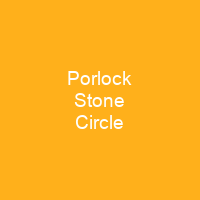Porlock Stone Circle: A Time Capsule of Ancient Britain
Imagine stepping back into time through the misty veil of history to a place where ancient Britons once gathered, perhaps for rituals or simply to mark their presence on this land. That’s what Porlock Stone Circle offers us today.
The Mystery of Porlock Stone Circle
Porlock Stone Circle is a stone circle located in the heart of Exmoor, Somerset, England. It dates back to the Late Neolithic and Early Bronze Age period, between 3300 and 900 BCE. This means it has stood for over 4,000 years, silently watching the changing seasons and the passage of countless generations.
What Makes Porlock Stone Circle Unique?
The circle consists of 13 green micaceous sandstone rocks, with ten upright stones and eleven prostrate ones. The largest gaps are on its north-west and east-southeast sides, creating a sense of mystery and intrigue. It’s like the circle is whispering secrets to those who dare to listen.
History and Rediscovery
The first recorded mention of Porlock Stone Circle was in 1975 when it was initially noted as an 8-stone row, but later confirmed to be a much larger structure. The circle’s rediscovery by E.T. MacDermot in the early 20th century marked the beginning of its modern history.
Excavation and Discoveries
In 1928, Harold St George Gray surveyed the site, and a resistivity survey was conducted in 2009. These surveys hinted at sub-rectangular structures around the circle. Excavations took place in 2013 but yielded no significant artefacts or sealed deposits. However, a four-spoked lead wheel dating back to Roman-British times was found buried within the circle during excavation.
Designation and Conservation
The site has been designated as a scheduled monument since 1979, ensuring its protection for future generations. Surveys show that the number of stones in the circle has decreased over time—from 21 in 1950 to just 10 by 2009. Additional stones have appeared, raising questions about their inclusion and the true nature of the circle’s heritage.
Porlock Stone Circle: A Piece of Prehistoric Art
Imagine standing at Porlock Stone Circle, surrounded by green micaceous sandstone rocks that have stood for millennia. It’s like stepping into a time machine where you can almost hear the whispers of ancient Britons. The circle is not just a collection of stones; it’s a living testament to our prehistoric past.
Connecting the Dots: Porlock and Other Exmoor Circles
Exmoor, with its lack of natural granite, has only two known prehistoric stone circles: Porlock and Withypool Stone Circle. The scarcity of large stones led to the use of smaller ones (miniliths) in these circles. This makes each circle unique yet part of a broader landscape of ancient monuments.
Porlock Stone Circle: A Monumental Landscape
Gillings suggests that Porlock Stone Circle is part of a wider monumental landscape, with possible dates for construction during the Early and Middle Bronze Age periods. The site’s designation as a scheduled monument ensures its preservation, allowing us to continue exploring its mysteries.
Conclusion: A Timeless Legacy
Porlock Stone Circle stands as a timeless legacy of our ancient past. It is more than just a collection of stones; it is a portal to the lives and beliefs of those who came before us. As we stand in awe, we can’t help but wonder about the stories these stones hold and what they might reveal if only we could listen.

You want to know more about Porlock Stone Circle?
This page is based on the article Porlock Stone Circle published in Wikipedia (retrieved on November 28, 2024) and was automatically summarized using artificial intelligence.







